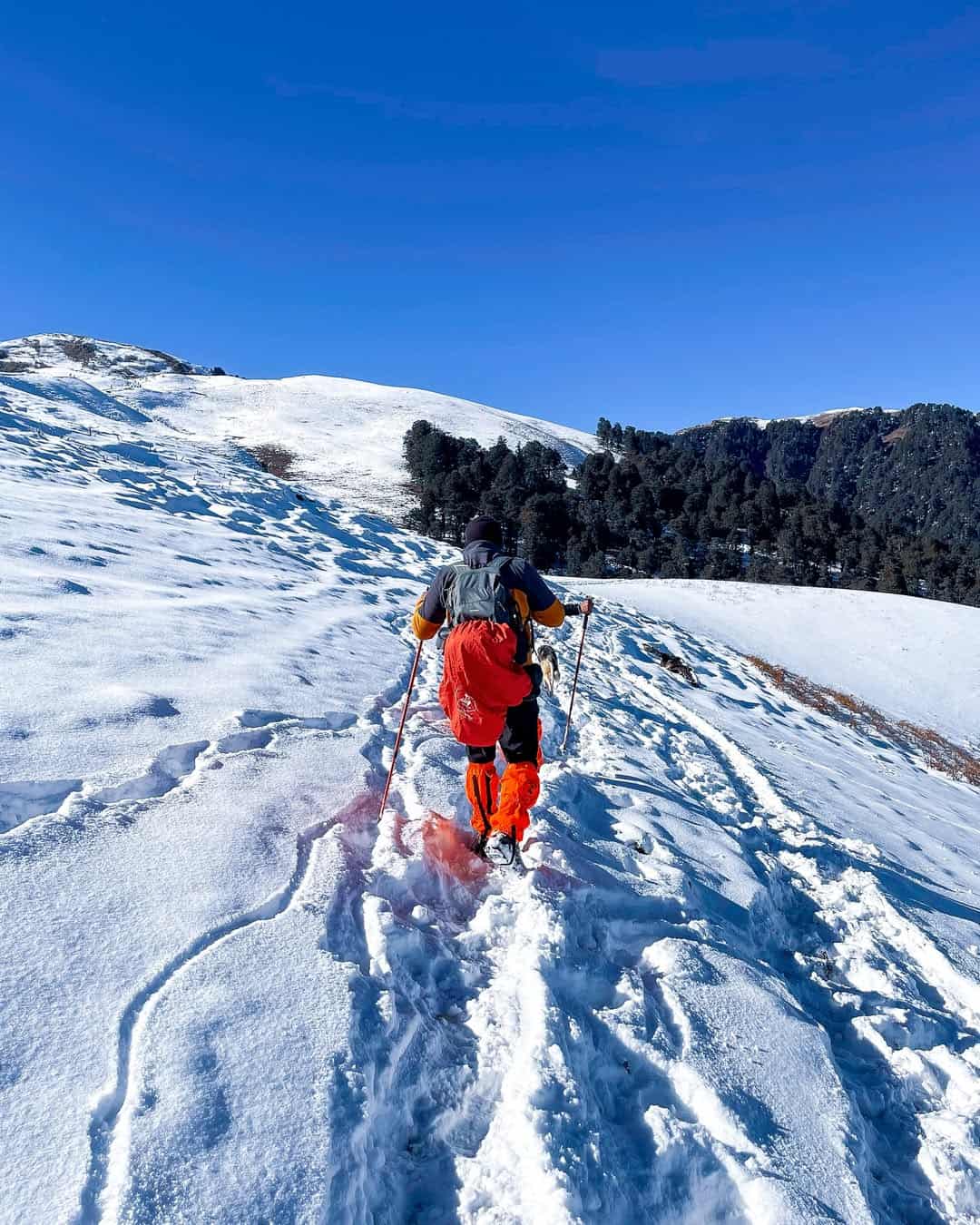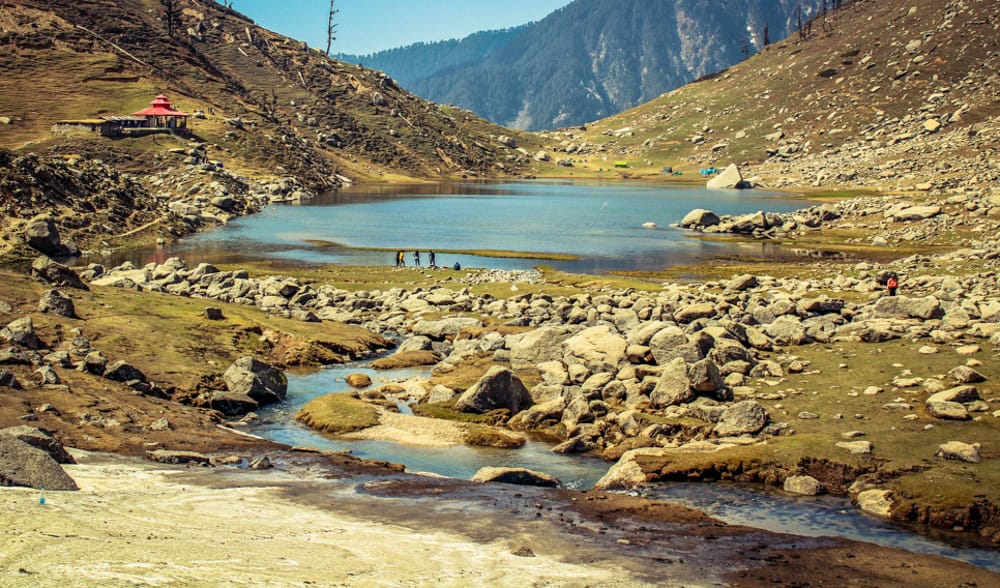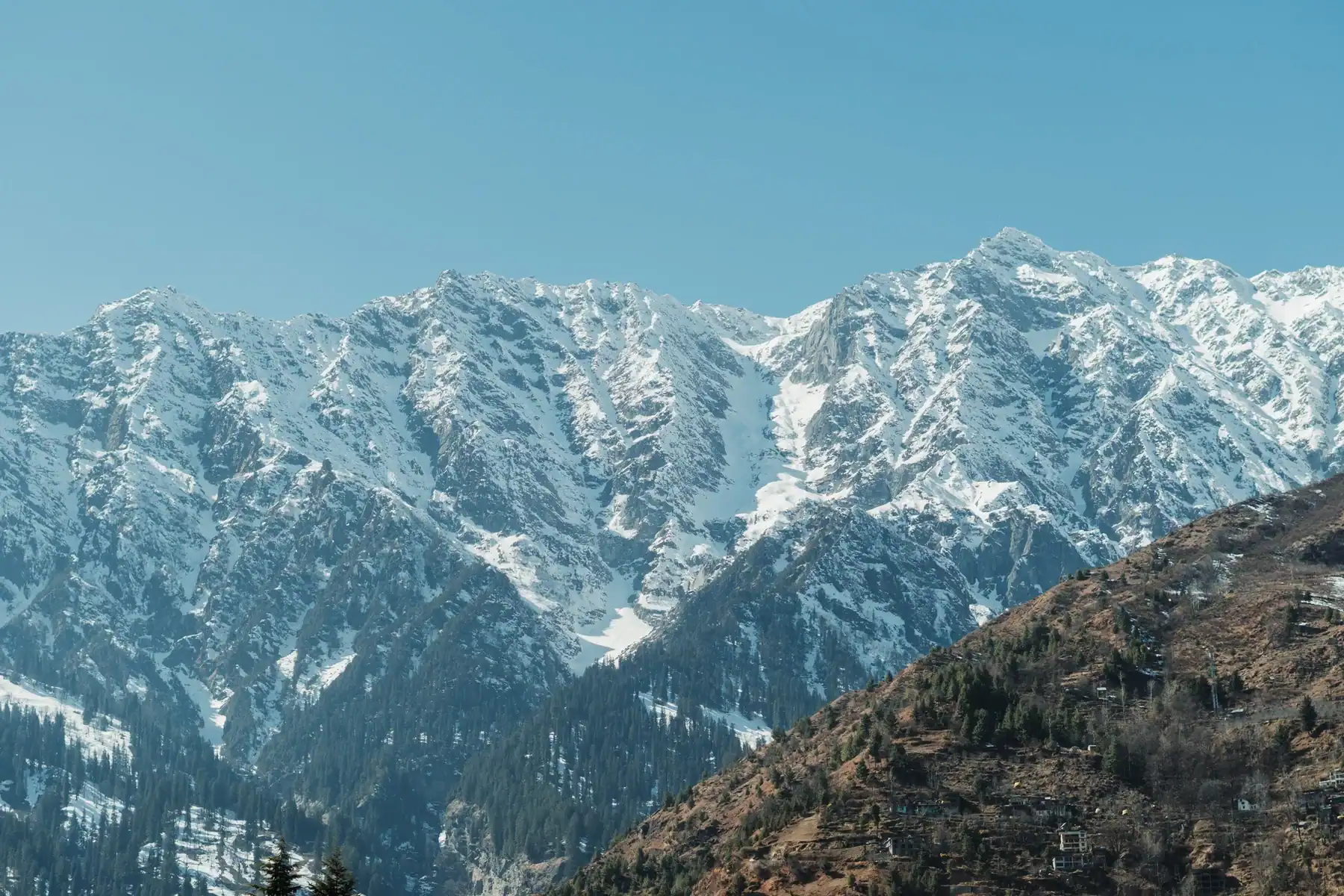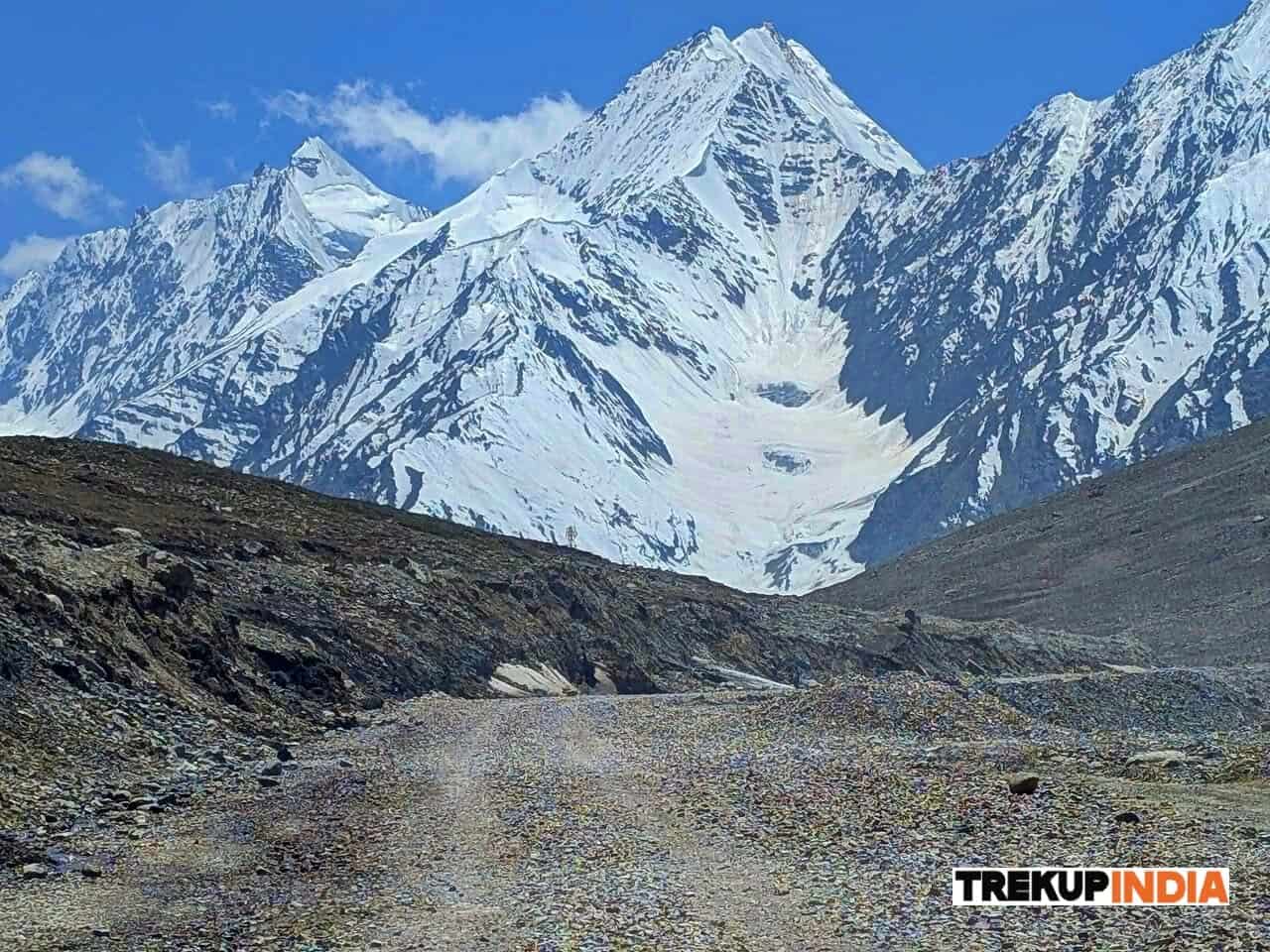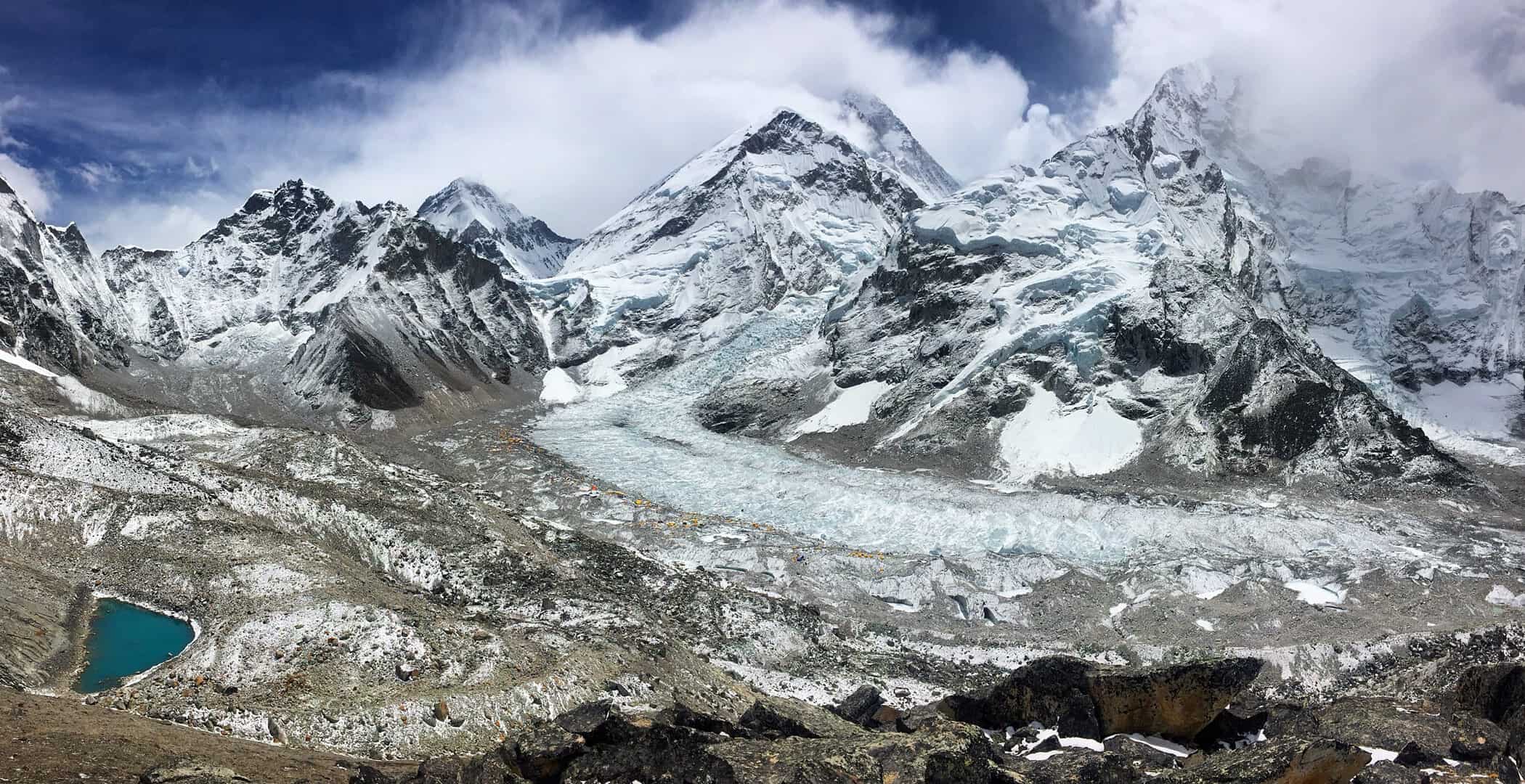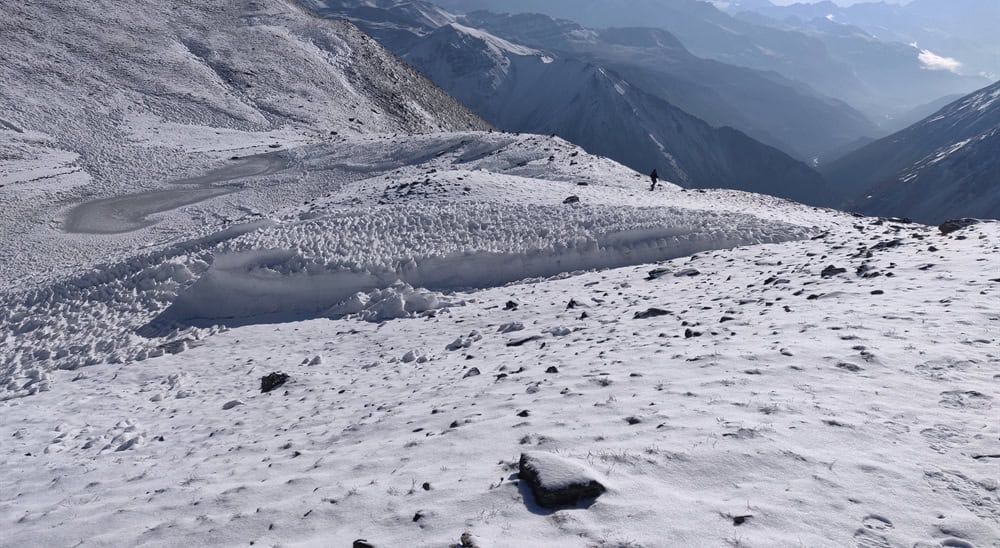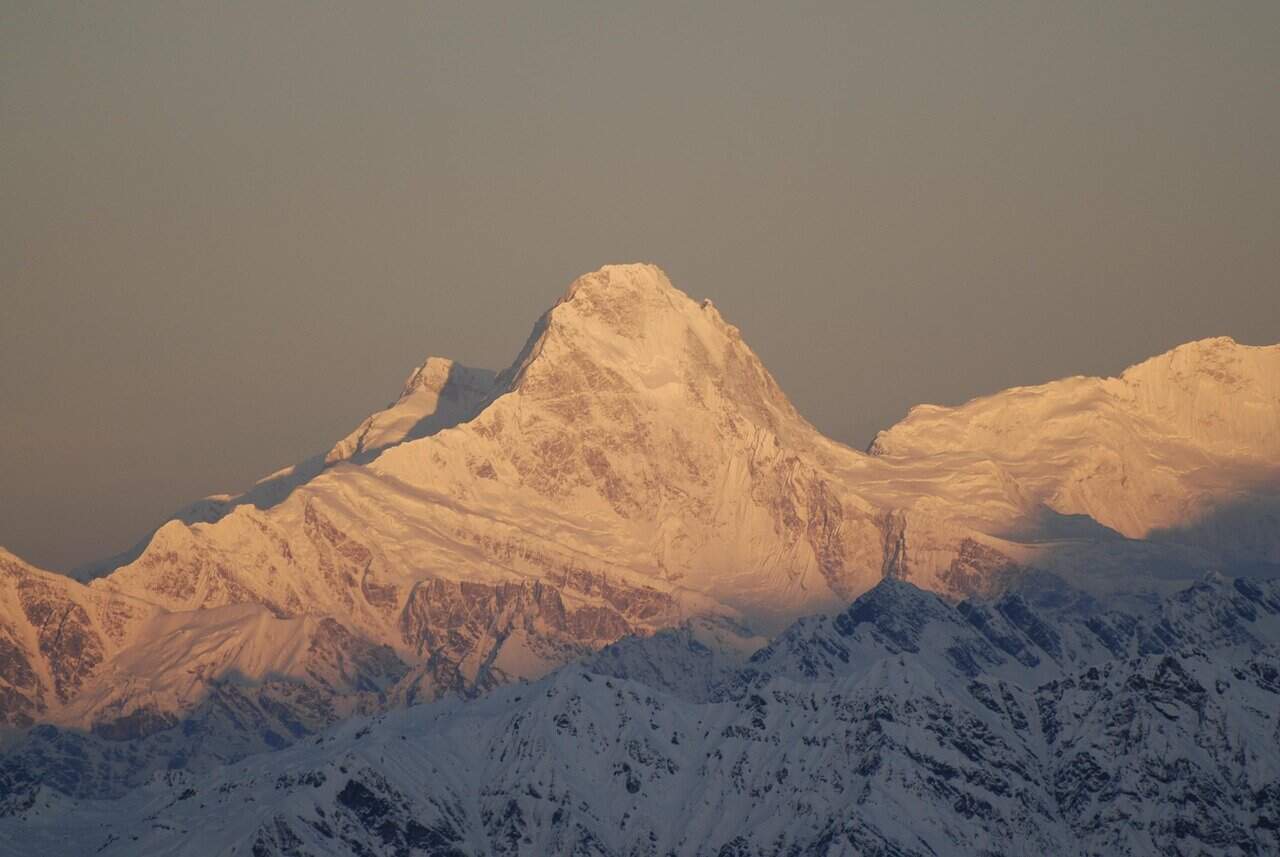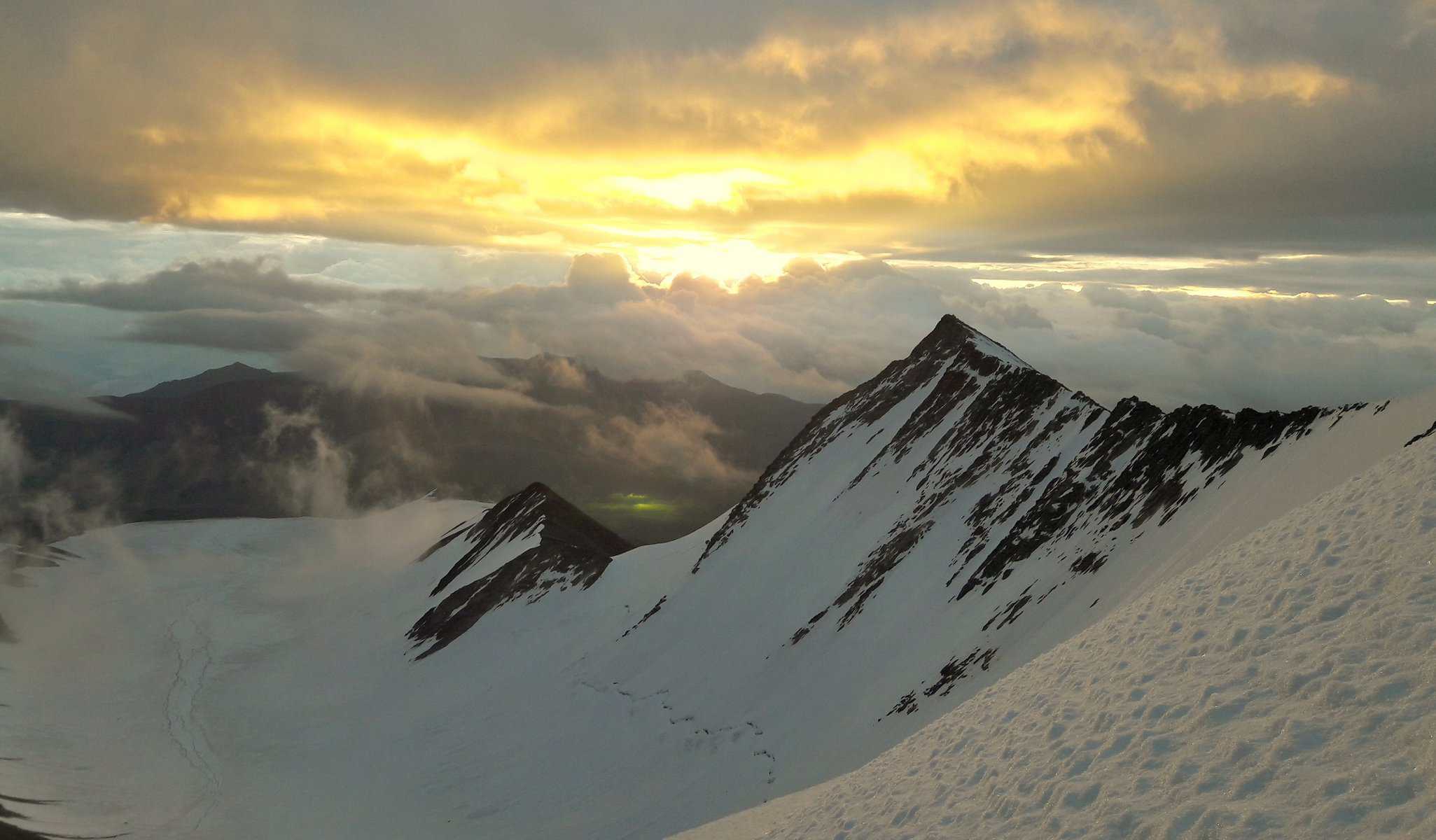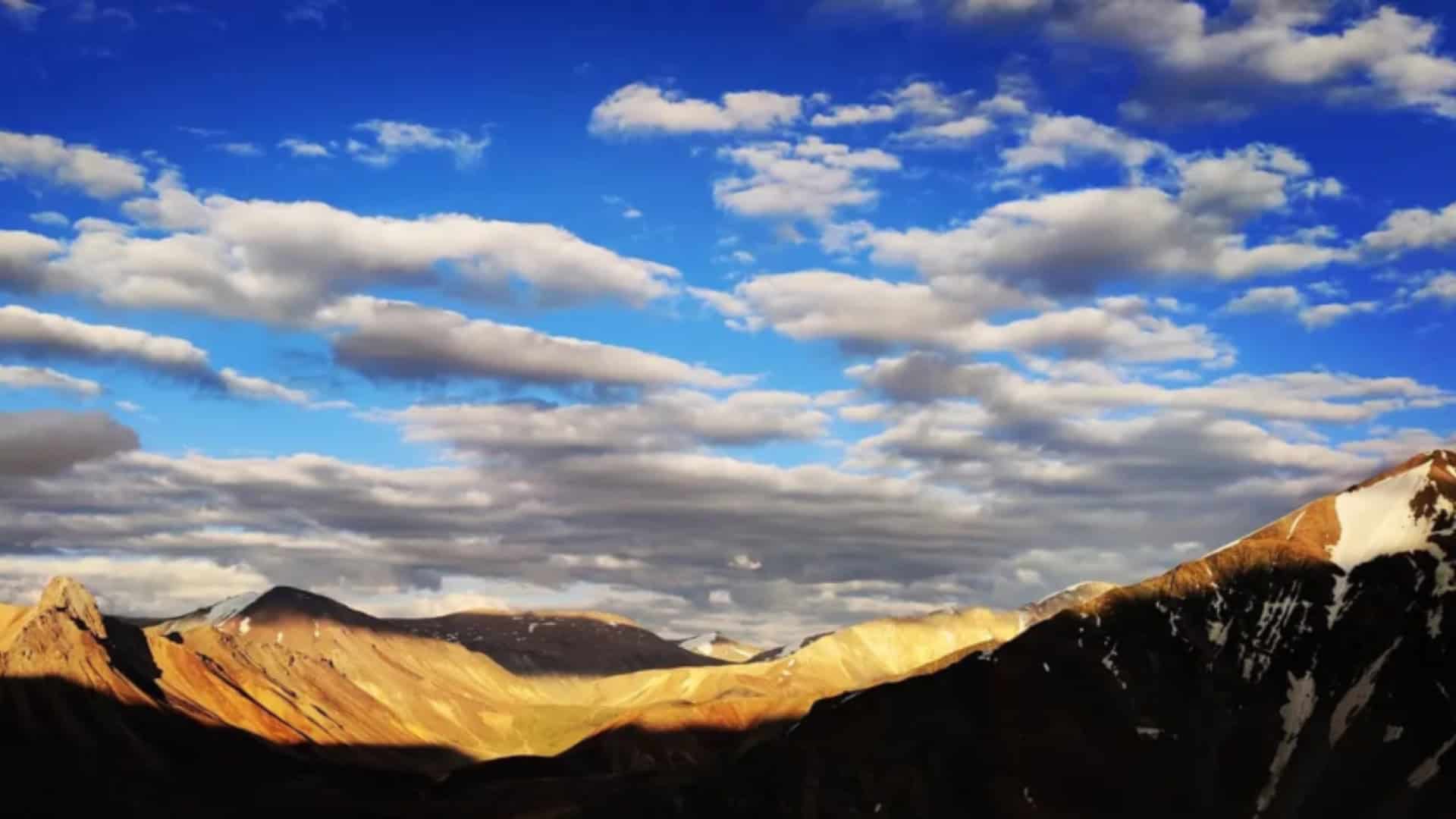Trek Grade
Moderate to Difficult
Highest Altitude
18307 ft
Base Camp
Kaza
Best Time
June to Sept
Parang La Trek
Parang La Trek is located in the Spiti region of Himachal Pradesh, Tibet & Changthang in the Ladakh region. This trek is difficult, and the trekker requires prior experience and expertise to complete it. They would be walking past some local villages, passing through old monasteries and beautiful landscapes of mountains. The picturesque view they would see is deep gorges, vast meadows, lakes, wildlife like snow leopards, and a high-altitude village. In this trek, they would encounter long glaciers, cross rivers, negotiate crevasses, and enjoy beautiful mountain meadows. This trek is along a wide glaciated pass which connects southeastern Ladakh to Spiti. Parang Leh Trek is famous for its cultural treasures, monasteries, palaces, and temples. There are some high settlements that they will pass on this trek, like Komic, Kibber, Langza, and Hikkim.
Trek Cost
- Stay will be on a twin-sharing basis in tents
Fix Diparture Dates
Parang La Trek Videos
Videos by experts watch these videos to prepare well for a Successful Trek

Want To Trek Like Pro?
Basically, watch these videos if you want to trek the same way professional trekkers do and make your skills better. These videos contain useful tips and techniques to further improve your trekking skills itself. These videos actually help both new and experienced trekkers improve their trekking skills. These videos definitely provide useful tips that make your trek better. We are seeing that these videos by Trekup India experts will only help you make your trekking skills better.
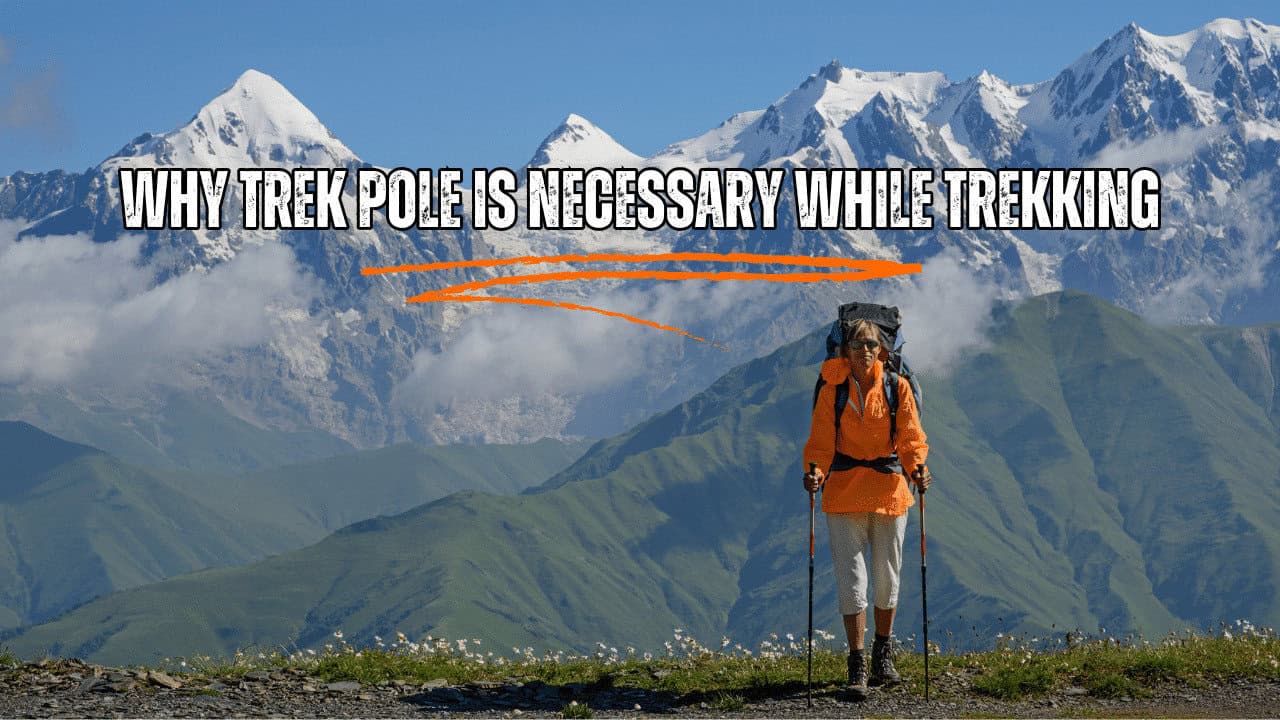
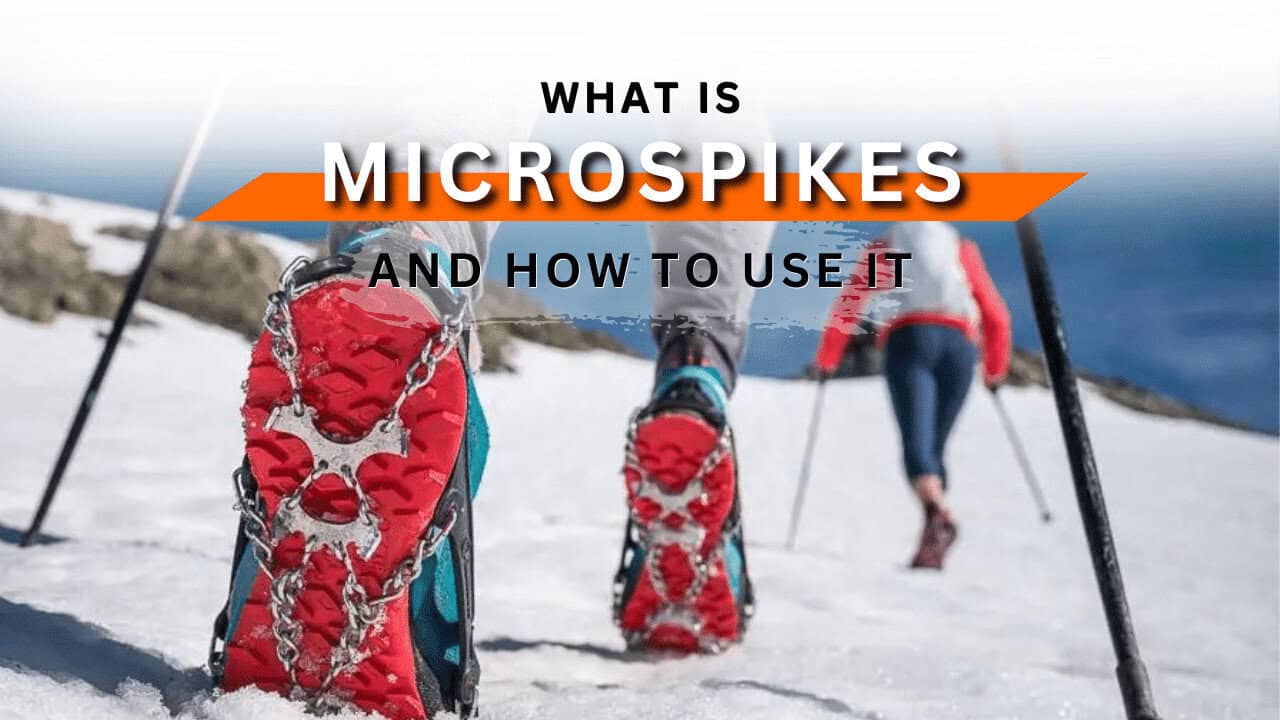
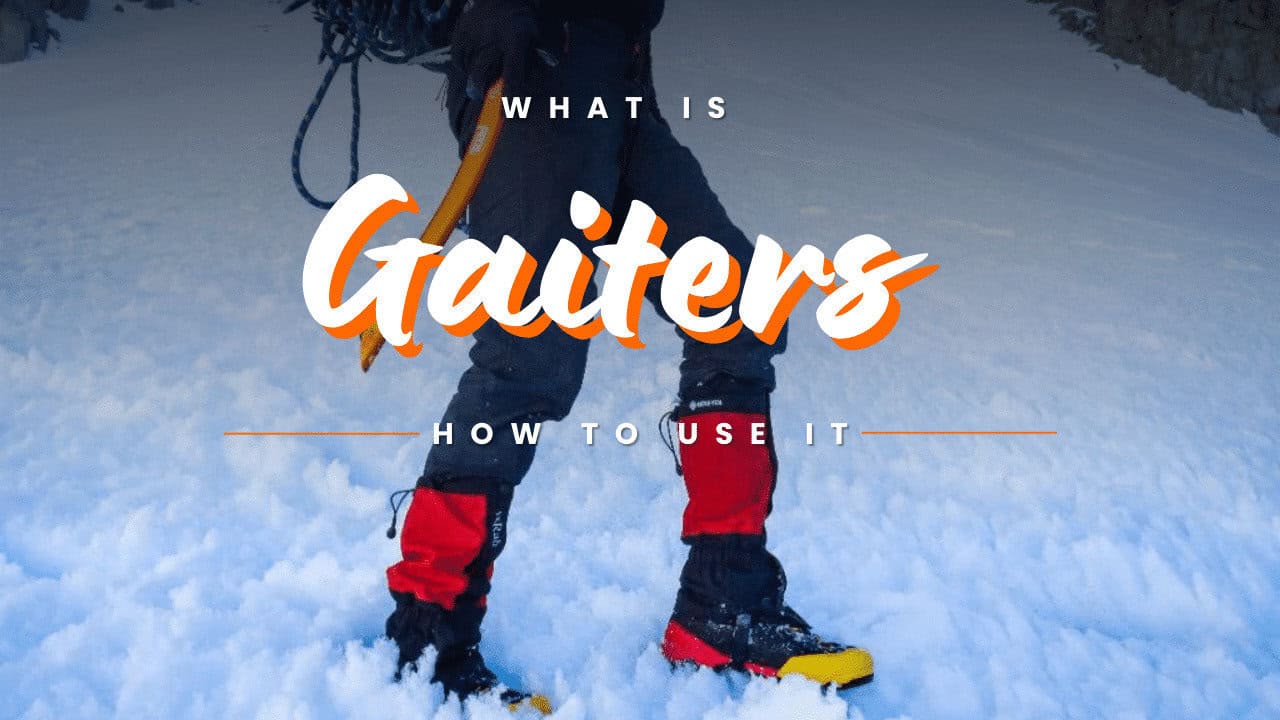
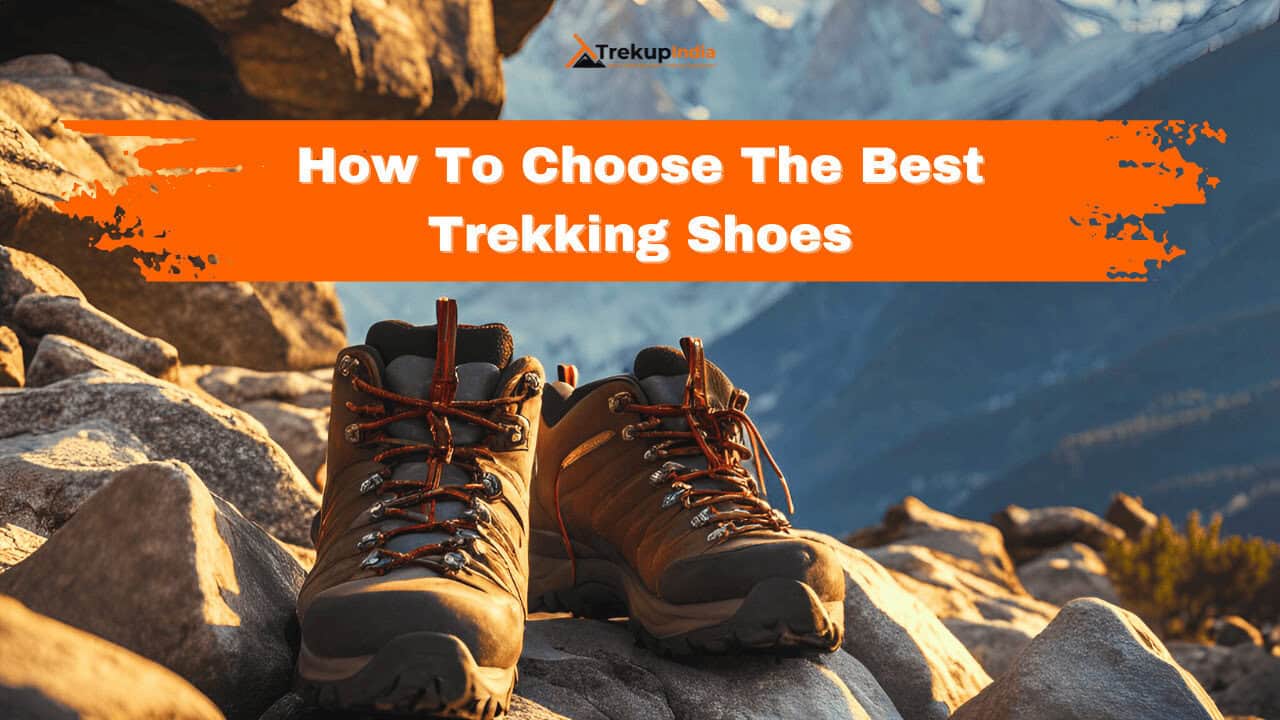
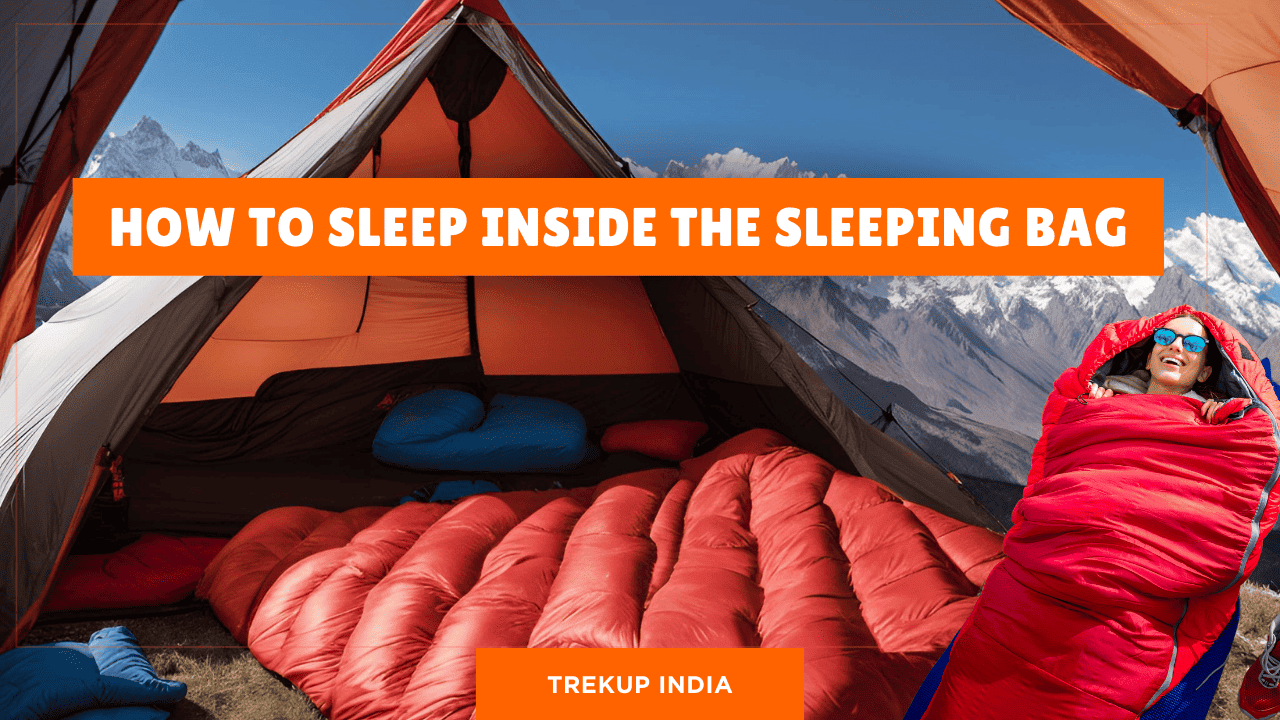
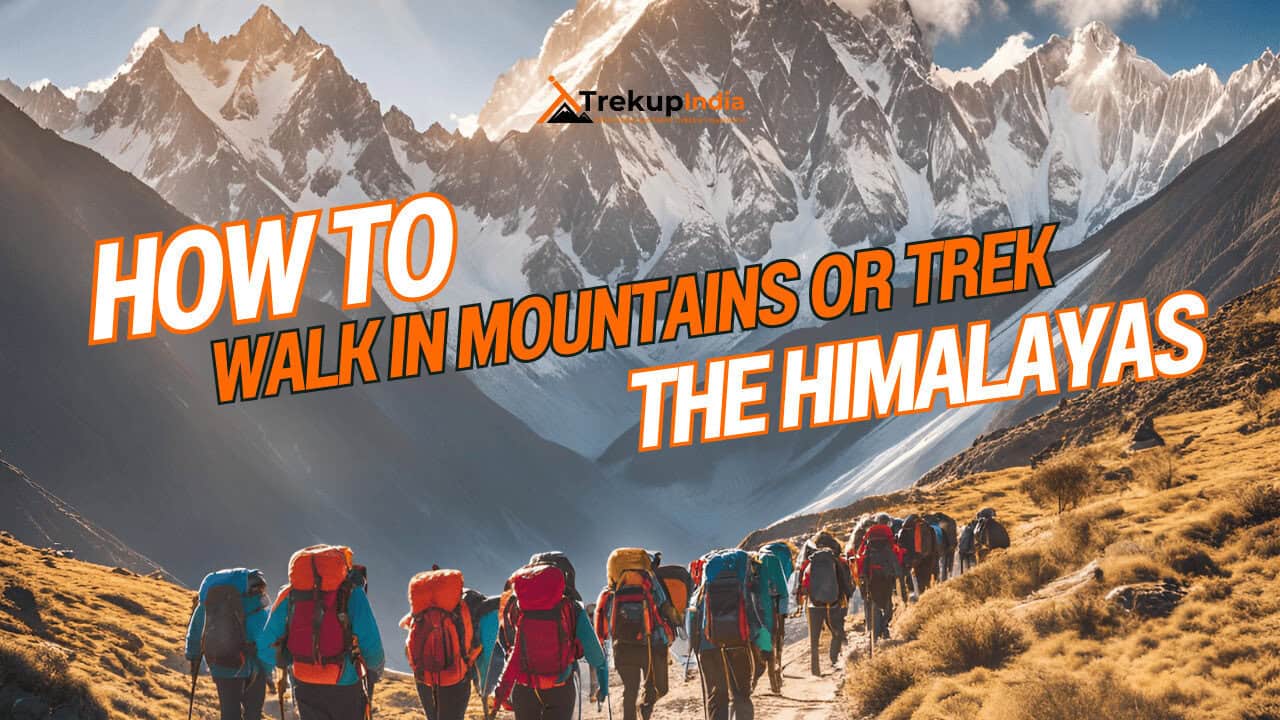
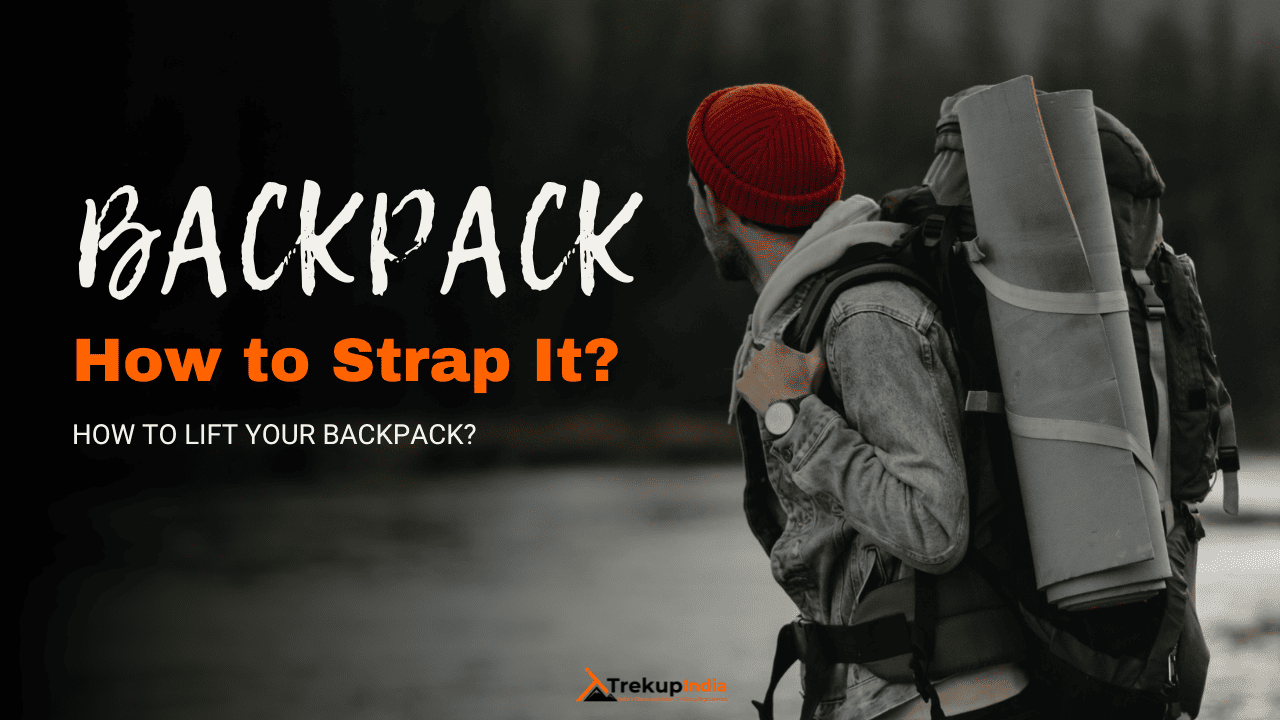
Know Everything About Acute Mountain Sickness
Acute Mountain Sickness occurs when people trek to high altitudes above 8,000 feet. This condition itself develops further due to reduced oxygen levels at such heights. Basically, as you go higher up, the air pressure and oxygen levels decrease, which causes the same problem. Acute Mountain Sickness surely causes headache, nausea, vomiting, and dizziness in affected persons. Moreover, peoples also experience difficulty in sleeping during this condition. To avoid mountain sickness, you should actually trek up slowly to higher altitudes. To learn further about this condition itself, watch the videos by Trekup India.
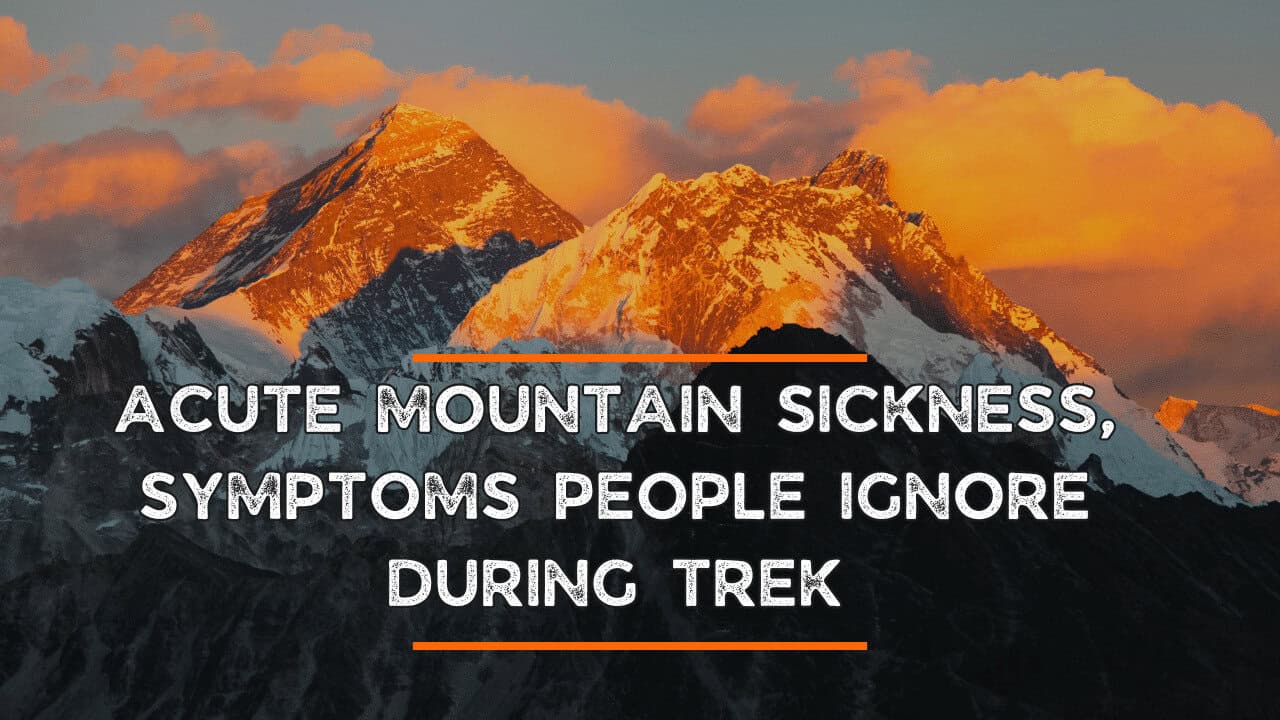
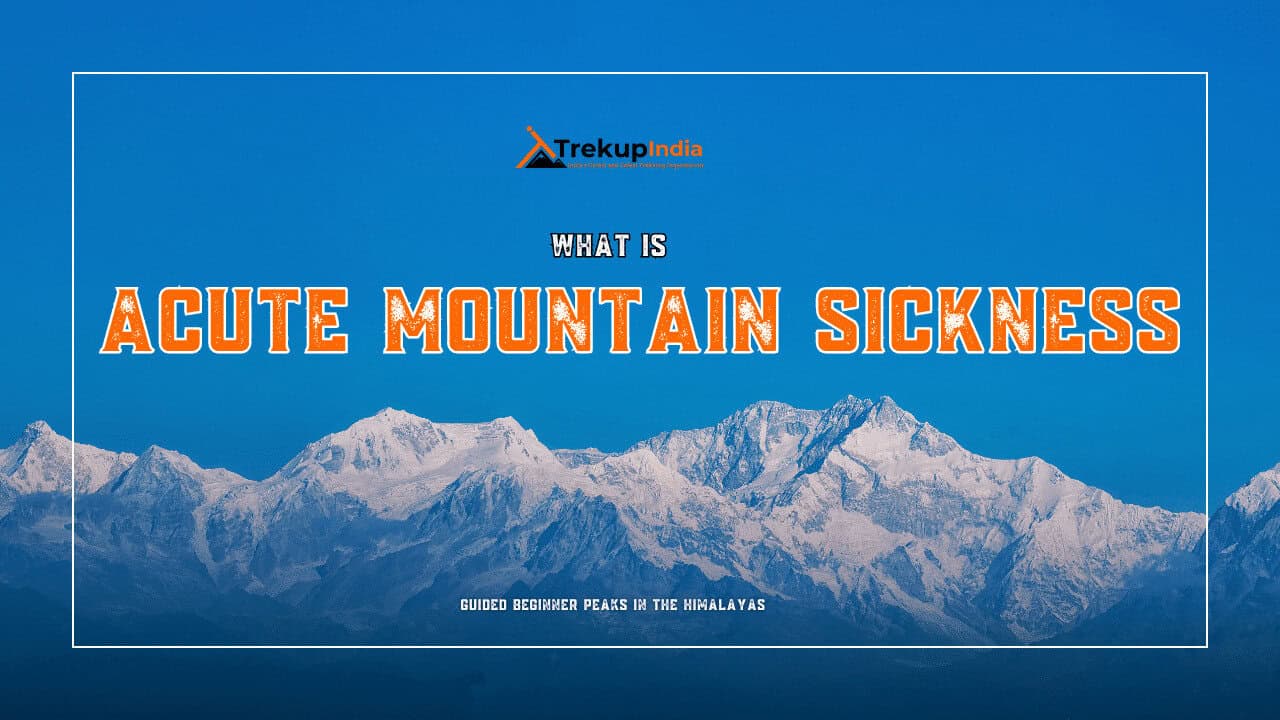
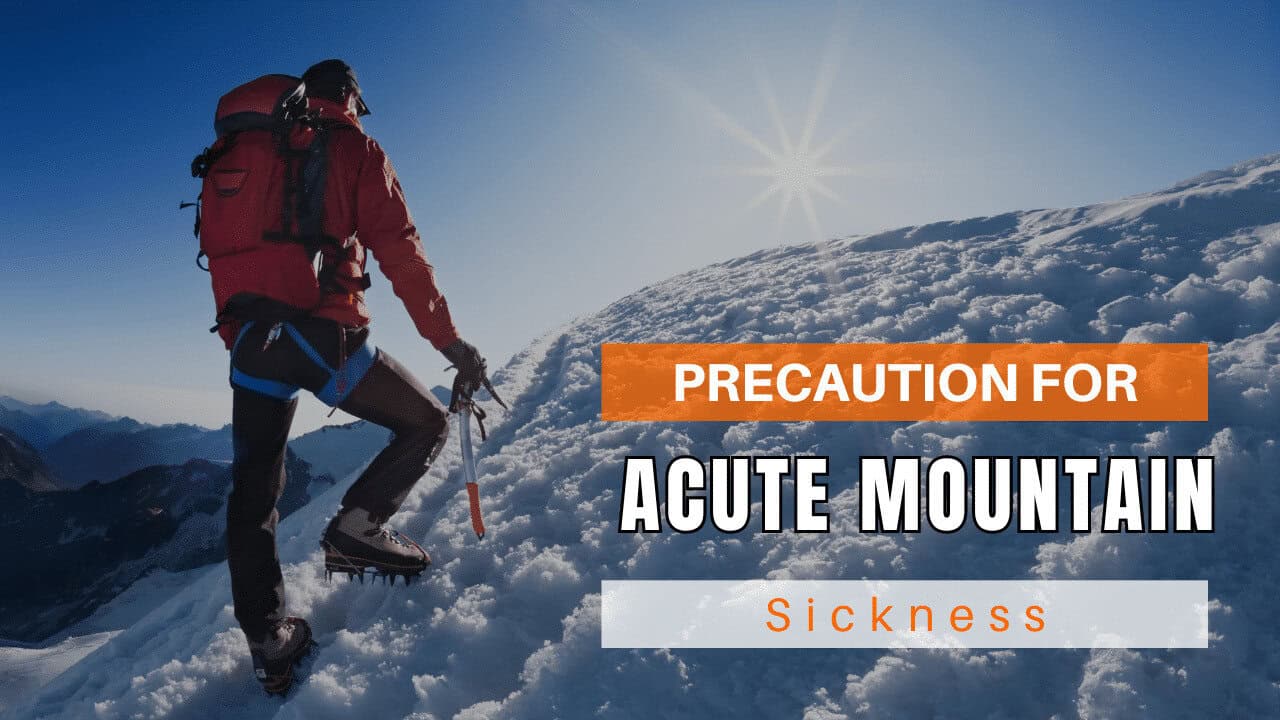
Day Wise Detailed Itinerary of Parang La
Day 1: Manali to Kaza by Road
- Stay – Overnight stay at the guesthouse/hotel.
- Meal – Dinner
- Distance – 202 km
- Time Taken – approx. 5 hrs
- Altitude – Manali (6730 ft / 2050 mtr), Kaza (11,980 ft / 3650 mtr)
- Altitude Difference – 5250 ft / 1600 mtr
- Trek Grade – By road
On the first day of their journey, they would begin their travel by road, and along the way, they would pass Rohtang Pass & Kunzum La. The trekkers would rest the day to get their bodies acclimatized to the high altitude. At Kunzum La, the trekkers could also visit the famous Kunzum Mata Mandir. As the trekkers drive from Kunzum La to Kaza, they will be enthralled by the beautiful Spiti River. When they reach Kaza, they would be welcomed by the key monasteries, and the trekkers could also explore the local market. Upon reaching Manali, they would be dropped off at the hotel by the Trekup India Representative, where they would be sleeping for the night.
Day 2: Kaza to Chicham by Road
- Stay – Overnight stay at the guesthouse/hotel.
- Meal – Breakfast, Lunch and Dinner
- Distance – 18 km
- Time Taken – approx. 50 min.
- Altitude – Kaza (11,980 ft / 3650 mtr), Chicham (13,615 ft / 4150 mtr)
- Altitude Difference – 1635 ft / 500 mtr
- Trek Grade – By road
The trekkers would begin their day with a warm breakfast and prepare for the day ahead. The trekker would use this day to rest and get acclimatized by walking and exploring Kaza, like walking along the Spiti River and visiting Monasteries & Gompa. After they had explored Kaza, the trekker would begin the drive towards Chicham, a short drive.
Day 3: Rest Day at Chicham
- Stay – Overnight stay at the guesthouse/hotel.
- Meal – Breakfast, Lunch and Dinner
- Altitude – 13,615 ft / 4150 mtr
The trekkers would begin their day with hot tea and the picture-perfect scenic views in front of their eyes. Chicham is famous for its suspension bridge, the highest in Asia. The trekkers would use this day to get their bodies acclimatized for the trek ahead. After the day’s excursion, the trekkers would return to the guest house or hotel and get ample sleep at night.
Day 4: Chicham to Thaltak by Trek
- Stay – Overnight stay at the campsite.
- Meal – Breakfast, Lunch and Dinner
- Distance – 8 km
- Time Taken – approx. 7 hrs
- Altitude – Chicham (13,615 ft / 4150 mtr), Thaltak (15,387 ft / 4690 mtr)
- Altitude Difference – 1772 ft / 540 mtr
- Trek Grade – Gradual
This day marks the first day of their trek, and the trekker would begin the day with hot tea. The trek from Chicahm would begin walking on the straight-led trail; the trekkers would soon start seeing the campsite at Dumla. Here, they would catch the water stream flowing in the middle of agriculture fields; from Dumla, the trail would begin ascending uphill with the view of Spiti mountains and zig-zag dirt trail, with locally grown vegetation of Tampa. As the trekkers reach Thalak, they would be enthralled by Kanamo Peak as it comes into view. Thaltak campsite has a fantastic idea with Kanmao peak in front and lush green meadows known as Thama bush. Rest for the night at the camp after the tiring day trek.
Day 5: Thaltak to Borochin by Trek
- Stay – Overnight stay at the campsite.
- Meal – Breakfast, Lunch and Dinner
- Distance – 12 km
- Time Taken – approx. 8 hrs
- Altitude – Thaltak (15,387 ft / 4690 mtr), Borochin (16,732 ft / 5100 mtr)
- Altitude Difference – 1345 ft / 410 mtr
- Trek Grade – Gradual to Moderate
The trekkers would begin their morning with a delicious breakfast and prepare for the day’s trek. As the trekker starts walking from Thaltak meadows, the trail leads through a rough trail with deep gorges, loose gravel & rocks. The trekkers would then begin a downhill walk till they reach the riverbed of gushing river locally called Rong Nala. From there on, the trekkers would climb uphill till they reach Jukhta campsite, after which they will soon pass through the barren valley of Borochin. When they reach the Borochin campsite, they will see a small following stream. At this campsite, the trekker would get to sleep under the picturesque landscape of mountains studded with stars.
Day 6: Borochin to Kharsa Yongma via Parang La by Trek
- Stay – Overnight stay at the campsite.
- Meal – Breakfast, Lunch and Dinner
- Distance – 14 km
- Time Taken – approx. 9 hrs
- Altitude – Borochin (16,732 ft / 5100 mtr), Parang La Pass (18,370 ft / 5600 mtr), Kharsa Yongma (15,912 ft / 4850 mtr)
- Altitude Difference – Borochin to Parang La Pass (1638 ft / 500 mtr), Parang La Pass to Kharsa Yongma (2458 ft / 750 mtr)
- Trek Grade – Moderate to Difficult
This day marks the primary day of the summit, where the trekker would be climbing the highest point of the trek. Trekup India Trek Leader will guide them and prepare them for the problematic level day trek, after which they will begin the trek through moraines. The trekkers would walk through the zig-zag trail until they reached Parang La. As the trekker reaches the top, they would be welcomed and spellbound by the view, which includes Spiti and Changthang valleys and Parilungi Peak. Once they have enjoyed the top picture, they begin their return trek, taking them to Parang La Glacier. As the trekkers reach Parang La glacier, they would walk past the glacier with the river flowing beneath. As they walk past the glacier, they must be extra careful as they pass through a few crevasses. The trekker would soon reach Lakku campsite; from there, it is just a few hours to the campsite, Kharsa Yongma. The trekkers would be sleeping at the camp, where they would hear the soothing sound of the river flowing and the fresh air of the mountains.
Day 7: Kharsa Yongma to Kapapuche by Trek
- Stay – Overnight stay at the campsite.
- Meal – Breakfast, Lunch and Dinner
- Distance – 20 km
- Time Taken – approx. 10 hrs
- Altitude – Kharsa Yongma (15,912 ft / 4850 mtr), Kapapuche (15,420 ft / 4700 mtr)
- Altitude Difference – 492 ft / 150 mtr
- Trek Grade – Gradual
This day marks the descent and the return journey; the trekker will begin their trek after breakfast. The trail today will be leading through the riverbed, and they will be crossing numerous streams. The route would also be passing through Datang Yongma & Datang Kongma, which are also the campsites. Catch a sight of Tsoma Nala flowing on the side of the Datang Yongma; on the way, they will also see Lasoma or Takli La Nala merging into Datang Nala after the Yongma campsite. After walking for some time, they would finally reach the camp at Kapapuche, where they would rest for the night.
Day 8: Kapapuche to Kitpodansa by Trek
- Stay – Overnight stay at the campsite.
- Meal – Breakfast, Lunch and Dinner Distance – 20 km
- Time Taken – approx. 10 hrs
- Altitude – Kapapuche (15,420 ft / 4700 mtr), Kitpodansa (14,930 ft / 4550 mtr)
- Altitude Difference – 490 ft / 150 mtr
- Trek Grade – Gradual to Moderate
On this day, the trekker would walk on the trail like the previous day, but the altitude would be reduced. The trekker would be walking along the Pare River riverbed, catching sight of multiple streams or Nala, merging into the Pare Chu River and another merging into Falangbado Nala. After walking for a while, the trekker soon reached Phalum Phada campsite, where they saw huge rock structures. Also, some small caves act as a reminder of the traders who used to find shelter in earlier times. The next place the trekker would be passing by Racholamo campsite, a merging point of 2 valleys; then the trekker crosses past Lakuk Nala, a major tributary river flowing near Racholamo campsite. After the day’s excursion, the trekker can rest at the camp and enjoy the scenic mountains. The next day, the trekker will ascend towards the mountain’s peak and take in the breathtaking views. After that, they will make their way back down and end the trek at the same campsite.
Day 9: Kitpodansa to Chumik Shilde by Trek
- Stay – Overnight stay at the campsite.
- Meal – Breakfast, Lunch and Dinner
- Distance – 18 km
- Time Taken – approx. 9 hrs
- Altitude – Kitpodansa (14,930 ft / 4550 mtr), Chumik Shilde (15,420 ft / 4700 mtr)
- Altitude Difference – 490 ft / 150 mtr
- Trek Grade – Gradual to Moderate
Beginning the day, the trekker would wake up with a healthy breakfast and hot tea, and the trail would be downstream of the Parechu River. The trekker will then pass Norbu Sumdo, and the route changes the landscape from riverbed to lush green meadows. Yellow flowers await on this trail; they would see wildlife such as Kiang (wild ass), a black wolf & Marmot. At the Chumik Shilde campsite, they would be enthralled by the green meadows and spring water. Have a good night’s sleep and take ample rest at night.
Day 10: Chumik Shilde to Kiangdom by Trek
- Stay – Overnight stay at the campsite.
- Meal – Breakfast, Lunch and Dinner
- Distance – 14 km
- Time Taken – approx. 8 hrs
- Altitude – Chumik Shilde (15,420 ft / 4700 mtr), Kingdom (15,060 ft / 4590 mtr)
- Altitude Difference – 360 ft / 110 mtr
- Trek Grade – Gradual
The trek would start on flat land and, through the dense green meadows, catch sight of the snow-covered peaks of the Mentok series. As they walk ahead on the trail, they start seeing Tso Moriri Lake, which is a very pristine lake. As they reach the Kiangdom campsite, they might get to see wild asses, as the place is named after wild Tibetan asses, locally known as Kiangs. The lake is the nesting ground for many beautiful birds migrating to this region. After the trekker has trekked for the day, they would automatically sleep early.
Day 11: Kiangdom to Karzok by Trek
- Stay – Overnight stay at the guest house.
- Meal – Breakfast, Lunch and Dinner
- Distance – 21 km
- Time Taken – approx. 9 hrs
- Altitude – Kingdom (15,060 ft / 4590 mtr), Karzok (15,130 ft / 4610 mtr)
- Altitude Difference – 70 ft / 20 mtr
- Trek Grade – Gradual
This day marks the last day of the trek, and the trekker will enjoy the scenic views of the mountains one last time. The trekkers would begin the trek along the Tsomorir Lake on the side; they would get a beautiful view of Chamsher Kangri Peak and Lungser Kangri Peak. The trekkers would experience the changing colour of the lake depending on the time of day. The trail towards Karzok village will be uphill, and it will take a few hours to reach the campsite. Kazok village is a perfect example of solitude, with few houses and homestays.
Day 12: Karzok to Leh by Road
- Meal – Breakfast
- Distance – 240 km
- Time Taken – approx. 6 hrs
- Altitude – Karzok (15,130 ft / 4610 mtr), Leh (11,562 ft / 3524 mtr)
- Altitude Difference – 3568 ft / 1086 mtr
- Trek Grade – By Road
On the last day of the trekkers’ journey, they would be driving through the mountains last time and taking in the serenity of the hills. They would be met by a Trekup India representative, who would then move them from Karzok to Leh. At Leh, the team would bid them farewell, and they would be on their own to explore Leh & the nearby area, or they could return home.
Parang La Trek Route Map
We’ve prepared a comprehensive Trek Route Map for your upcoming adventure to Parang La Trek, which outlines the entire journey including all stops and trails. This map provides detailed information on the terrain, distance between points of interest, and estimated travel time to help ensure a safe and enjoyable trek. We’ve carefully curated the map to ensure that you have all the necessary information at your fingertips. Please take a moment to review it thoroughly, and don’t hesitate to reach out if you have any questions or concerns.
Parang La Trek Altitude Chart
The Trek Altitude Chart is a useful tool for Trekkers to monitor their altitude changes during their rides, allowing them to plan their routes more efficiently and track their progress over time. This Parang La Trek chart is beneficial for both casual and experienced Trekkers, helping them make the most out of their Trek experience.
Trek Cost Inclusions
- Stay 8 Nights of tented accommodation at respective campsites of Trekup India on a sharing basis and three days in the guest house.
- Meals: Trekup India provided cooked meals during the trek, starting with Dinner on Day 01 to Breakfast on day 12 (Meals are simple, nutritious, and vegetarian and non-repeated meals)
- Transport: Manali to Kaza, Kaza to Chicham and Karzok to Leh on sharing jeeps
- Trek Insurance (Optional): Trekup India recommends that all trekkers consider getting trek insurance. This is optional, but highly recommended. Trek insurance covers unexpected events that may occur during your trek. The cost of the insurance starts from INR 210. Please read more about what is included in the coverage and why it is mandatory on treks.
- Trek Equipment: Sleeping bag, Sleeping tents, Kitchen tent, Dining tent, Toilet Tent.
- Amenities: All utensils, sleeping mattresses (Black foam mats), Crampons, and Gaiters for snow.
- Health & Safety: First Aid Box, Oxygen Cylinders, Stretchers, Oxi meters, BP Machines, health.
- Permits: Forest Permits and Camping Permission Fee
- Trek Crew: High Altitude Chef, Helpers, Trek Leader & Guides, and other support teams.
- Potters & Mules: Potters and Mules are to carry all trekking equipment, ration, and vegetables.
Trek Cost Exclusions
- GST 5% (it is Mandatory)
- Any Meals/accommodation beside the itinerary or not mentioned in the program.
- Any Bus / Airfare to/from trek start/end point
- Personal Medical expenses do carry your medication.
- Any personal services such as Laundry, phone calls, liquors, mineral water, etc.
- Any still / video camera fee
- Any Entrance fee Monuments, Monasteries, Museums, Temples – Pay directly on the spot.
- Mules or porter charges to carry private baggage (Offload Charges for bag 365 per day, per bag if paid online (at base camp 2,550). Note: Bag weight should not be more than 10 kg.
- Any emergency evacuation charges
- Any services that are not mentioned in the cost inclusion section.
What should you pack for the Parang La Trek
Parang La Trek is a high-altitude trek. The trekking gear you have to have for this particular trek differs from normal treks. Thus, read this whole segment. There is an important question that the trekker who is doing trek asks, like what all things to carry while trekking. Below, we have provided the details on everything you should take; an easy way to remember is by Head to foot or foot to head. We have prepared from Head to foot.
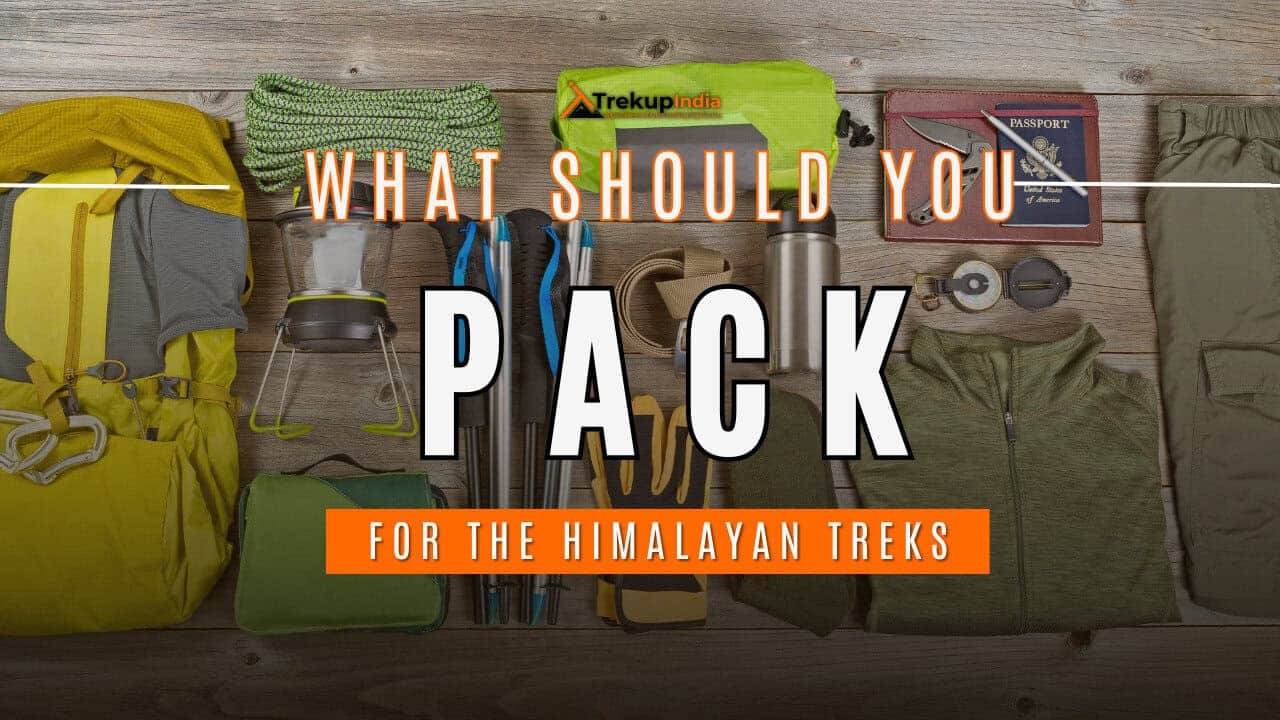
Head Gears
When trekking it's important to carry headgear to protect your head and face.
Heading out for a trek? Don’t forget to carry headgear to protect your beautiful face and head from the sun, wind, and dust! It’s an essential accessory that keeps you safe and comfortable throughout your adventurous journey. So, make sure you pack it before you step out into nature!
- Head Lamps – When trekking at night, headlamps are essential to illuminate your path while keeping your hands free. Headlamps come in different sizes and lumens, so it is essential to choose one that suits your needs.
- Hats or Cap – Caps or hats are also necessary when trekking in different weather conditions. Caps protect your head from the wind and freezing temperatures at night, while hats provide shade and protection from the sun during the day. It’s essential to ensure that your hat has a strap to prevent it from being blown away by the wind.
- Sunglasses – Sunglasses are also essential for trekking. Your sunglasses should protect your eyes from harmful UV rays and fit your face perfectly to avoid falling off while climbing, jumping, or crossing obstacles. The glass of your sunglasses should also be designed for different weather conditions to provide optimal visibility.
- Buff / Balaclava – Lastly, a buff or balaclava is a must-have to protect your mouth or neck from extreme temperatures and keep them warm. Buffs and balaclavas come in different materials, thicknesses, and designs, so it’s important to choose one that suits your needs and preferences. Depending on the weather conditions and your activities, you can wear them as neck warmers, face masks, or headbands.
Clothes
When trekking in high altitudes, prepare for cold weather by wearing layers. Layering traps heat, keeps you warm, and allows you to easily adjust your clothing as temperatures fluctuate.
Layering is important for different seasons when trekking. When planning a high-altitude trek, it is important to prepare for the cold weather. Wearing layers is the best approach as it provides both protection and flexibility when the weather changes frequently in the mountains. Layering helps to trap heat and keep your body warm, while at the same time allowing you to easily adjust your clothing as the temperature fluctuates. By wearing layers, you can enjoy your trek comfortably and stay safe in the unpredictable mountain weather
- For spring, summer, and monsoon treks, consider wearing three layers: a woollen sweater, a fleece, and a padded jacket.
- For autumn treks, add one more fleece layer to make it four layers.
- For winter treks, you may need five layers with thermals, a woollen sweater, two fleeces, and a padded jacket.
- T-shirt/sleeve shirt– Bring three T-shirts and two quick-dry trek pants, wearing one and carrying the others. Long sleeve shirts help to protect from sun UV rays. We recommend synthetic T-shirts as they get dry quickly when they get wet.
- Hiking / Trekking Jacket– down jackets (-5 to-10 C) or two-three-layer jackets.
- Thermals– at least two pairs of thermals help keep the body warm during cold weather.
- Undergarments– you can carry them according to your habitual and hygiene requirements.
- Gloves– 1 pair of gloves will keep your hand warm and nice.
- Trek Pants– Bring 2 to 3 comfortable trekking pants. Trekking pants play a significant role, as they are designed for comfort and mobility, making trekking easier. It should be Synthetic so that it gets dry quickly when wet.
- Rain Wear– you can carry a raincoat or Poncho. During long rains and snowfalls, the waterproof jackets start leaking. Still, the Poncho and raincoats keep you dry, so choose accordingly.
Tip: If you choose a raincoat on your trek, carry a small waterproof cover so things inside your backpack can’t get wet. If you carry a Poncho, you don’t need to worry. It protects both you and your backpack.
Foot Gears
When it comes to planning a trek, one of the most important aspects is to ensure that you have the right kind of foot gear.
- Trekking shoes which are waterproof and have ankle support. Walking / Hiking sandals which can be used off the trek, i.e., in the morning and evening hours when you reach the campsite, basically to get your feet rest from heavy boots, sometimes used for crossing streams and rivers, it’s more comfortable and safer than crossing barefoot or wetting your shoes. Sneakers (Optional) can be worn for normal driving days or used around the camp.
- Socks– you should at least carry 3 to 4 pairs.
- Microspikes & Gaitorswill be provided by Trekup India when required. You don’t have to carry them.
Personal First Aid Kit
Don't forget to pack your personal first aid kit! It's always better to be safe. So, make sure you're prepared for any unforeseen circumstances.
Below are some common medicines generally required/used during your adventure trip; however, please consult your doctors prior.
- Antiseptic towel or water syringe (to clean the wound)
- Butterfly bandage for a small cut
- Cotton and elastic bandages and sterile gauze pad for larger wounds
- Latex gloves are used when the wound bleeds.
- Medicine for Diarrhea (Upset stomach)
- Medicine for cold, flue/fever, headache
- Some pain killers
- ORS pouches
- Quick pain relief spray (External use)
- Any personal medicine prescribed by your doctor
- Dimox / Similar for high altitude sickness
- Bug Repellent
- Carry some nutria/energy bars and drinks (non-alcoholic)
- Note: Kindly consult your doctor before purchasing or taking any medicine.
Gadgets and Other Items
You might also consider bringing a camera, binoculars, portable charger, and snacks. Be well-prepared and tackle any trail with confidence.
- Trekking Poles
- Mobile phone
- Camera
- Spare batteries for phone and camera, power bank
- Lightweight flashlight or headlight
- A waterproof bag made of plastic is used for the camera.
- Plug/converter for electrical items
- 1-litre water bottle
- A journal with a pen would be a good idea to keep your notes.
- Some book of your interest for the ideal time
- Get into the habit of maintaining a Map and guidebook of the region.
Hygiene & Personal toiletry
Remember to pack hygiene and personal toiletry items such as soap, shampoo, toothbrush, toothpaste, deodorant, and toilet paper.
- Sunscreen with UV protection to shield your skin from harmful rays
- 1 or 2 small quick-drying towels to help you dry off quickly in case of rain or sweat
- Toilet paper, tissues or wet wipes for maintaining hygiene while on the trek
- Toothbrush, toothpaste, and mouth freshener to keep your mouth clean and fresh throughout the journey
- Deodorant or talcum powder to help you stay fresh and odor-free, especially during hot and humid climates
- Shampoo to keep your hair clean and healthy
- Sanitary pads or tampons (for female trekkers) to manage menstrual cycles
- Lip-gloss or salve to protect your lips from dryness and chapping
- Bio-degradable soap to keep yourself clean and hygienic while on the trek
- Nail clipper and other personal items that you use daily
Compulsory Documents to Carry
There are certain documents that you should always carry with you. These documents are not only necessary for your safety and security, but they may also be required by local authorities.
These files must be submitted to the Forest Department before your trek. With none of these, you will not be permitted to trek—original and photocopy of government photo identity card. Carry IDs like Aadhaar, voter ID, etc.
How To Plan Your Trek & Reach Manali
By Air: Bhuntar Airport, Kullu, is the nearest airport to Manali by flight and is located almost 50 km away from Manali and 11 km from Kullu. However, if they plan to reach Manali by flight, it is better to come one day in advance.
By Train: If they want to reach Manali from Delhi by train, they can catch the train from New Delhi Railway Station to Jogindernagar Railway Station, which is 5 hours away from Manali. They can check the railway chart and book accordingly, and it’s better to book in advance.
By Bus: From Delhi, they can find a regular bus service to Manali. ISBT Kashmere Gate is the central bus station in Delhi, where they will find both AC and non-AC buses for Manali. They can take two different routes from Delhi, Chandigarh, Dehradun, and Ambala.
However, taking government buses from Kashmere Gate ISBT is always better. The bus will drop them at Manali, and then we will send our staff, who will pick them up from Manali Bus Stand.
Fitness Required & Preparation Guide For Parang La
If you’re preparing for a Parang La, Trekup India recommends jogging as part of your fitness routine. Jogging helps work out the same muscle groups that you’ll use during trekking and can help you build endurance. You don’t need any special equipment to get started.
Fitness Target
Trekup India has put the Parang La Trek into an moderate to difficult grade-level trek.
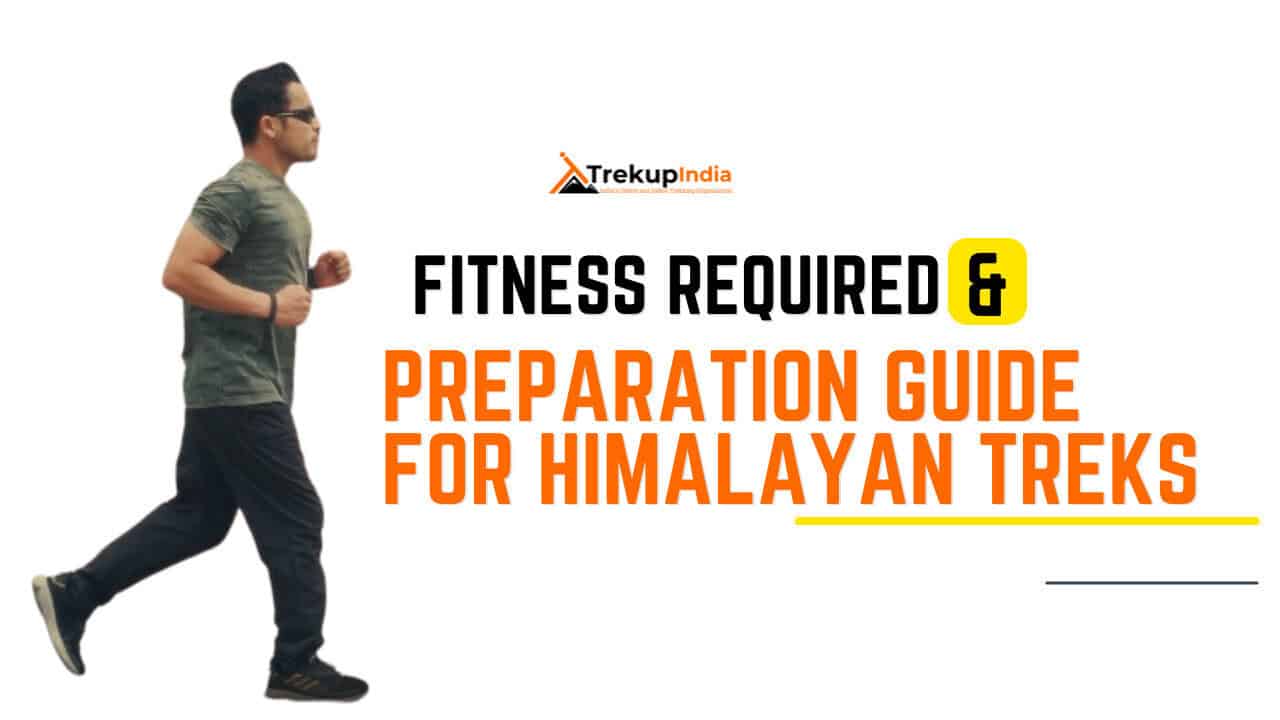
For Moderate – Difficult Treks – In order to be well-prepared for your upcoming trek, it is recommended that you focus on building your endurance by aiming to cover a distance of 4.5 kilometers in less than 40 minutes. This will help you to develop the necessary stamina and strength required to successfully complete your journey.
How to Achieve This Fitness Target?
To start preparing for your trek:
- Try jogging for at least five days every week.
- If you find 5 km too difficult at first, begin with 2 km and gradually increase over 2-3 weeks.
- Once you feel more comfortable running 5 km, focus on improving your speed gradually on a daily basis.
It is important to ensure that you can consistently complete 4.5 km in under 40 minutes for at least two weeks before your planned trek. Allow yourself 6-8 weeks to prepare physically for the journey.
Strength Training exercises that benefit Trekking
Trekking is an activity that demands a good level of strength.

Trekking is a demanding activity that requires good cardiovascular endurance, muscular strength, and overall fitness. To help you prepare for your trek, incorporating bodyweight exercises into your training routine can be an effective way to build strength, improve stability, and enhance endurance, all of which are crucial for a successful trek. In this regard, here’s a breakdown of body weight exercises categorized by the specific body parts they target and the benefits they offer during trekking.
1. Lower Body Exercises
Lower body exercises like squats and lunges are great for building lower body strength, essential for trekking.
a. Squats
Squats are an excellent exercise for building lower body strength, essential for trekking. They target the quadriceps, hamstrings, glutes, and calves. Solid quadriceps and glutes provide power for ascending and tackling uphill climbs, while vital hamstrings aid stability during descents. This is particularly helpful in navigating uneven terrain during trekking.
How to perform Squats Exercises:
- Stand with feet shoulder-width apart, toes pointing slightly outward.
- Lower your body by bending your knees and hips, keeping your back straight.
- Lower until your thighs are parallel to the ground or as low as comfortable.
- Push through your heels to return to the starting position.
b. Lunges
Lunges target the quadriceps, hamstrings, glutes, and calves. They improve lower body strength, balance, and stability, crucial for maintaining control on rocky trails and steep slopes. Additionally, they enhance flexibility, reducing the risk of injury while trekking.
How to Perform Lunge Exercises:
- Stand with feet hip-width apart, hands on hips or sides.
- Take a step forward with one foot, lowering your body until both knees are bent at 90-degree angles.
- Push through the heel of your front foot to return to the starting position.
- Repeat on the other side, alternating legs.
2. Upper Body Exercises
Upper body exercises such as push-ups and pull-ups effectively strengthen the upper body, especially the chest and shoulders, which are essential for carrying a backpack during treks.
a. Push-Ups
Targets: Chest, shoulders, triceps, and core.
Benefits for Trekking: Push-ups are an effective exercise to strengthen the upper body, especially the chest and shoulders, essential for carrying a backpack during treks. Improved upper body strength will also help maintain posture and stability while traversing challenging terrain.
How to Perform Push-Ups Exercises:
- Start in a plank position with hands shoulder-width apart and body in a straight line from head to heels.
- Lower your body by bending your elbows until your chest nearly touches the ground.
- Push through your palms to return to the starting position.
- Keep your core engaged throughout the movement.
b. Pull-Ups/Bodyweight Rows:
Targeting the back, biceps, and shoulders can significantly benefit trekking. You can strengthen these muscle groups by performing pull-ups or bodyweight rows and improve your posture and balance while carrying a backpack. Additionally, more muscular back muscles can help reduce the risk of back strain and fatigue during long treks, making your journey safer and more comfortable.
3. Core Exercises
Core exercises like planks and Russian twists can help strengthen the core muscles, which are crucial for maintaining stability and balance while trekking on uneven terrain.
a. Planks
Targets: Abdominals, obliques, and lower back.
Benefits for Trekking: Planks are an effective exercise that helps strengthen the core muscles. These muscles are crucial for maintaining stability and balance while trekking on uneven terrain. A strong core also helps improve posture, reducing the risk of back pain and fatigue during extended hikes.
How to Perform Planks Exercises:
- Start in a plank position with elbows directly under shoulders and body in a straight line from head to heels.
- Engage your core and hold the position, avoiding sagging or arching the back.
- Keep breathing steadily and hold for the desired duration.
b. Russian Twists
Targets: Obliques, abdominals, and lower back.
Benefits for Trekking: Russian twists engage the core muscles, particularly the obliques, improving rotational stability and balance. Enhanced core strength helps prevent injuries and improves overall performance during trekking.
How to Perform Russian Twist Exercises:
- Sit on the ground with knees bent and feet flat, leaning back slightly to engage the core.
- Clasp hands together and twist the torso to one side, bringing the hands towards the ground beside the hip.
- Return to the centre, then twist to the other side.
- Continue alternating sides for the desired number of repetitions.
4. Full Body/Cardiovascular Exercises
Full-body/cardiovascular exercises like burpees and mountain climbers are excellent for improving cardiovascular endurance, strength, and agility.
a.Burpees
Burpees are an excellent full-body exercise that targets your legs, chest, arms, and core. This exercise dramatically benefits trekking enthusiasts, improving cardiovascular endurance, strength, and agility. Regularly incorporating burpees into your workout routine can enhance your overall fitness level, which can help you endure long hikes and rugged terrains with ease.
How to Perform Burpees Exercises:
- Start in a standing position.
- Squat down and place hands on the ground.
- Jump feet back into a plank position.
- Perform a push-up.
- Jump feet back to the squat position.
- Explosively jump up into the air, reaching overhead.
- Land softly and repeat the sequence.
b. Mountain Climbers
Mountain climbers target the core, shoulders, chest, and legs. This dynamic, full-body exercise can significantly improve cardiovascular endurance and agility. It is an excellent functional workout for trekking preparation as it engages both the upper and lower body muscles while strengthening the core muscles.
How to Perform Mountain Climbers Exercises:
- Start in a plank position with hands shoulder-width apart and body in a straight line from head to heels.
- Drive one knee towards the chest, then quickly switch legs, alternating in a running motion.
- Keep the core engaged and the hips stable throughout the movement.
- Continue at a moderate to fast pace for the desired duration.
Incorporating bodyweight exercises into your training routine can help you build strength and endurance and prepare your body for the physical demands of trekking. Consistency and proper form are crucial to maximizing the benefits of these exercises and ensuring a safe and enjoyable trekking experience. Engaging your core muscles, including obliques, abdominals, and lower back, with Russian twists can improve your rotational stability and balance, preventing injuries and enhancing overall performance during trekking.
When incorporating strength training exercises into your workout routine, it’s essential to maintain proper form and technique to avoid injury. Start with lighter weights and gradually increase the intensity as you progress, focusing on compound exercises targeting multiple muscle groups simultaneously. Some examples of practical strength training exercises for trekking include squats, lunges, deadlifts, and pull-ups.
Remember to give your muscles time to recover between workouts, and remember to stretch before and after your workouts to prevent injury and improve flexibility. Combining strength training with jogging and proper stretching allows you to take your fitness to the next level and confidently tackle even the most challenging treks.
Our Trekkers Reviews And Expreinces
Food Provided by Us During Trek
We provide only Indian vegetarian food, and your meal will mainly consist of Indian bread, vegetables, lentils, rice, and a delicious dessert. During your trek, we will serve three meals a day, including breakfast, lunch, and dinner. You will also be served tea, snacks, and lip-smacking soup in the evening before dinner. If it is a long day of trekking, you will be given a packed snack.
After extensive research on the trekkers’ nutritional requirements, we prepare the menu. Before putting all the meals together, we also consider the altitude and the weather.
The meal we serve during the trek is perfectly balanced with calories, carbohydrates, vitamins, protein, fibre, and minerals. You need to know that all our cooks have great expertise in cooking and have undergone thorough training. So, get ready to enjoy delectable and lip-smacking dishes during your trek. You will be served with lemon tea in the tent to start your day with a refreshed feeling. Before leaving the campsite for trekking, you will be given a hot finger-licking breakfast like upma, Aallu Prantha, Besan Chilla, Poha, Daliya, Corn flakes, and Maggie, along with tea or coffee.
If your trek is longer, we also offer some fresh local fruits such as apples and healthy drinks like Frootie or Maaza. In the afternoon, you will be served a simple & healthy lunch, while at around 04:00 pm, you will be given tea and a light evening breakfast. After you reach your campsite at night, you will be served a hot and delightful dinner.
After reading this, you must have understood the food we provided on the trek; you don’t need to worry about food. Many trekkers repeatedly trek with us because of the food we provide. Thus, we will give you unforgettable experiences.
Safety During Parang La Trek
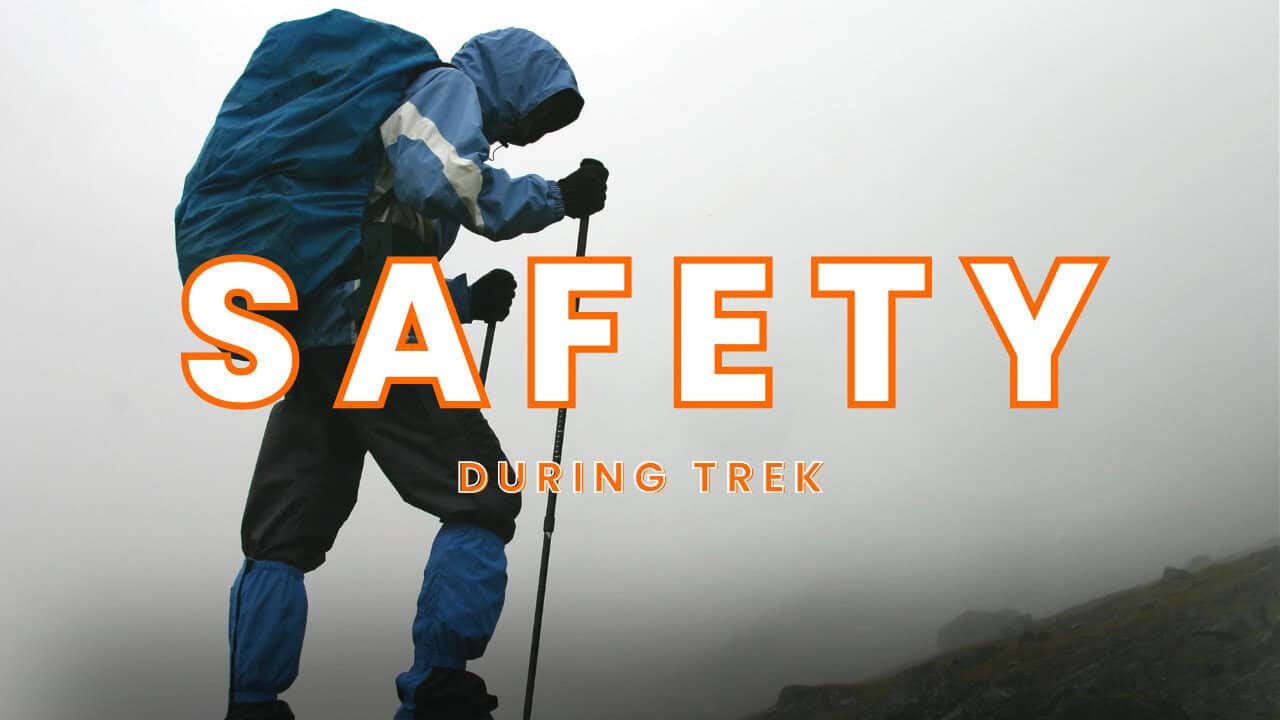
Trekking with us for the Parang La Trek is entirely safe because we have a team of trek leaders qualified in Wilderness first-aid and complete information about the high-altitude glitches. During the trek, we carry a full first-aid kit that contains all the essential medicines. Before trekking with us, you must ensure that you are medically fit for the trek; for us, your medical fitness is more important than anything else.
Right from our establishment, we at Trekup India have been continuously introducing new safety practices into Indian trekking to ensure the safety of voyagers. Trekup India introduced microspikes and made emergency bottled oxygen mandatory for all treks. Our trek leaders take your daily Pulse oximeter reading. We at Trekup India introduced the radio walkie-talkie as a safety communication device.
How can we ensure that your trek is safe with us?
We have noticed that most trek-organizing organizations do not follow these systems, but with time, they are following us; several competing companies are adopting these practices and organizing great, safe treks.
We ensure complete technical safety in the mountain. Our company has a vast team of more than 100 guides and trek leaders who serve on Himalayan treks. One of the best things about our team is that all the members are trained professionally by the Nehru Institute of Mountaineering, Indian Mountaineering Foundation Delhi, and Hanifle Center Outdoor Education Mussoorie.
Explore our New Safety Protocols
To ensure a perfect Trek, we have introduced some new safety checks to ensure excellent safety for our trekkers.
Our On-trek safety checks include:
- Daily oxygen saturation, along with pulse readings
- Stretchers team appointed on every trek
- Radios
- Trained mountain staff and complete safety
- Additional oxygen cylinders
- Special medical kit for high-altitude treks
- Microspikes on all types of snow treks
- Experienced Trek leaders, as well as safety
- Technical team on all snowy slopes
For Us, Your Safety Is the Top Priority
At Trekup India, you will find a team with local knowledge and fluency in English and Hindi. This helps ensure that you have a fantastic trek. Not only this, but we also pay attention to your health and safety because this is something we cannot ignore. All the team leaders involved in trekking have already undergone several professional courses in first aid, portable altitude chamber training, CPR, environmental awareness training, and advanced wilderness emergency medicine.
We also carry a complete first aid medical kit on every trek and trip we organize. Apart from the medical kit, we take a portable altitude chamber (if needed) and medical oxygen for all high-altitude treks. Our company has significant expertise in organizing all sorts of group adventure holidays for family groups, school and college groups, and friend groups. We have many travel options that suit different fitness levels and travelling styles.
Regardless of the group size, we value each and every member of our trekking groups. Our commitment to personal attention ensures that your needs and safety are always our top priority.
Who we are?
Trekup India has been a stalwart in the Adventure Tourism industry for 30 years. Since our inception, we have been dedicated to providing top-notch treks, voyages, trekking programs, and high-altitude expeditions. Our extensive experience is a testament to our commitment to your adventure and safety.
We organize treks in Uttarakhand, Kashmir, Sikkim, and Himachal while being part of the trekking community; we feature more than 75 documented Himalayan treks. In addition to other outdoor activities, our company also organizes trips for schools, colleges, and families.
Therefore, we maintain the quality of services offered to our valuable customers.
Must Read These Information Of Parang La Trek
Why You Should Do Parang La Trek?
Parang La Trek offers huge mountains, varied-colour structures, cliffs with rock sections, and vast expanses of green meadows. On this trek, the trekker also gets to pass through the breeding ground of famous Spiti horses, and it is also known to be snow leopard country.
1. The trekkers would get to see wildlife on this trek.
This region is home to snow leopards, black wolves, bar-headed geese, Tibetan sheep, black-necked cranes, marmots, brahminy ducks, and Kiangs (Tibetan wild ass).
2. Get enchanted by the magnificent snow-covered peaks.
On this trek, the trekker would be catching sight of the twin peaks of Chamsher and Lungser Kangri, along with spectacular views of K2. Up high, Kanamo Peak comes into the picture when they trek towards Thaltak when the trekker is walking towards Chumik Shilde, where they would be seeing the Mentok series.
3. Culture and traditions the trekker would get to experience.
The trekkers could visit the local monasteries and Gompa at Chicham to experience the culture and tradition up close. They also get to see agricultural fields with water flowing in the middle.
4. The trekker would be walking past the Long Parang glacier.
As the trekker walks over the Parang glacier, they hear a gushing river below their feet. Parang Glacier is also the source of the Pare Chu River; they also get to walk along the river, a picturesque sight of a river flowing and rocky barren hills in the background.
5. There is a local lore behind the Name Tso-moriri.
There was another name for Tso-mo-riri lake in the days of yore. Tsomoriri consists of three words: Tso, which means extensive lake in Ladakhi / Spitian; Mo, which means girl, and the meaning behind Tsomoriri’s third part is fascinating.
During a winter festival in a neighbouring village, a Changpa tribesman asked his daughter to take care of their livestock herd. She got terrified after goats, yaks, and horses escaped the livestock enclosure. In the distant reflection of the frozen lake, she saw distant yaks. As she approached the lake, she saw all her yaks, horses, and goats crossing it.
Herds are controlled and directed by Changpas using the ri-ri sound. The herd didn’t hear the call and continued walking in the other direction. As she approached the herd, a ruptured ice sheet below her caused her to drown. In memory of this tragic event, the lake was named Tsomoriri by the locals.
Best time to do Parang La Trek
The best time to do the Parang La Trek is June and September. In June, the trekker would experience the extended snow cover and snowscapes. During August and September, they will see the view of vast green meadows, desert brown landscapes, and snow-capped peaks.
Frequently Asked Questions About Parang La Trek
What is the duration Of the Parang La Trek
Its a 12 days and 11 nights trek


